ISSN ONLINE(2319-8753)PRINT(2347-6710)
ISSN ONLINE(2319-8753)PRINT(2347-6710)
Dinesh E. D1, Arun A. P2 and Pranav R1
|
| Related article at Pubmed, Scholar Google |
Visit for more related articles at International Journal of Innovative Research in Science, Engineering and Technology
Material requirements planning (MRP) systems is a prominent approach to manage the material flow and components on the factory floor. MRP technique- is used to explode bills of material, to calculate net material requirements and for production planning. The master production schedule and bill of materials indicates the materials to be demanded, order scheduling, cycle time production and supplier lead times then these all factors jointly determine when orders should be placed. It is a time phased priority-planning technique that calculates material requirements and schedules supply to meet demand across all products and parts in one or more plants and used to optimize the inventory. It controls the system that attempts to keep adequate inventory levels to assure that required materials are available when needed. This method is used for a automobile servicing plant for procuring spare parts to reduce the servicing time of a vehicle. The demand is forecasted for the materials based on actual demand and this gives the expected levels of goods or services. Based on the forecasted demand material requirement planning is done and orders are released to purchase materials and the materials are stocked. The objective of this work is to reduce the idle time and cost of materials and by procuring materials in right time
Keywords |
| Material Requirement Planning, priority planning, Inventory, Automobile, procuring. |
INTRODUCTION |
| X Company, a young and vibrant company in India, has grown since its inception in 1997 and today's dynamic business environment offers us many unique opportunities. As a leader in the automotive sector, our major challenge is to innovate continuously; keeping in mind the changing needs of customers, stakeholders and society at large. In order to counter these challenges, company follows the best practice. |
| Having laid the second foundation for our operations in India, we are now at an important stage. Further, our renewed 'Vision and Mission' direct us towards ultimate goal of becoming 'the most admired company in the country. It is a valued corporate citizen the world over. In India, it contributes to society through its efforts in the areas of education, community care and the environment. X Company in India will continue to delight its customers through advanced technologies and services, thereby fulfilling its commitment. |
LITERATURE REVIEW |
| Hyoung-Gon Lee, Namkyu Park, Han-Il Jeong and Jinwoo Park , (2009) proposed a grid enabled MRP process in a distributed database environment and demonstrates the performance improvement of the proposed process by a simulation study and divided into five parts. It begins with a review of the literature dealing with MRP and grid computing technology. The second part involves establishing MRP that leverages grid resources and accommodating the data management issue. The third part explains the experimental procedure and analytical results for different circumstances. The fourth discusses dealing with the implications of the data management issue, and finally the article concludes with several suggestions for future studies. Enterprise resource planning (ERP) software, are used in the production planning for manufacturing enterprises to ensure that appropriate quantities of raw materials and subassemblies are provided at the right time. Whereas little attention has been paid to the architectural aspects of MRP process in academic studies, in practice, reports are often made of its time consuming characteristics due to intensive interactions with databases and difficulty in real time processing. |
| Vincent A. Mabert, (2007) , This article chronicles many developments and events during the formative years of MRP, highlighting changes in computer technology and contributions by key early proponents of this approach for managing the flow of material on the factory floor. This early work provided the foundation to the inventory management literature frequently referred to as independent demand management. It led to the development of numerous reorder order point (ROP) systems like base stock, continuous review, periodic review, etc. Much of this work was done manually, using pencil and paper, a slide rule or a simple tabulating machine available during the 1930s and 1940s. The approaches normally focused upon single level stocking decisions, even though many companies were dealing with multi-echelon material flow on the factory floor. |
| Karl Inderfurth, (2009) Traditional MRP systems suffer from several weaknesses, one of them being the disregard of uncertainties like those referring to demand and supply quantities. Advanced MRP concepts handle these uncertainties by incorporating safety stocks and scrap allowances into order release calculations. However, they fail to address how these measures of risk protection might interact. Here, it is shown by using analyses from stochastic inventory control, how the performance of MRP-generated control rules can be assessed and how appropriate control parameters for MRP can be determined. And from this investigation is that a sound theory-supported way exists for choosing the parameters for advanced MRP control by which both demand and yield risk are appropriately taken into consideration. |
PROBLEM DEFINITION |
| MRP is a tool to deal with these problems: |
| ïÃâ÷ What items are required? |
| ïÃâ÷ How many are required? |
| ïÃâ÷ When are they required |
| Problem in industry: |
| ïÃâ÷ Lack of Inventory management that leads to over stock and under stock. |
| ïÃâ÷ Service time increases due to unavailability of material and do not meet due date. |
| ïÃâ÷ Rescheduling occurs due to improper planning and increases delivery time |
METHODOLOGY |
| These problems can be solved by following steps: |
| 1. Assessment of the present situation. |
| 2. Studying Bill of Materials. |
| 3. Forecasting demand using linear regression method. |
| 4. Design of MRP processes and system. |
| 5. Master production schedule for inventory. |
| 6. Planned order release. |
| 7. Implementation. |
OVERVIEW OF MRP |
| MRP is concerned with both production scheduling and inventory control. It is a material control system that attempts to keep adequate inventory levels to assure that required materials are available when needed. MRP is applicable in situations of multiple items with complex bills of materials. MRP is not useful for job shops or for continuous processes that are tightly linked. MRP is especially suited to manufacturing settings where the demand of many of the components and subassemblies depend on the demands of items that face external demands. Demands for end items are independent. In contrast, demand for components used to manufacture end items depend on the demands for the end items. The distinctions between independent and dependent demands are important in classifying inventory items and in developing systems to manage items within each demand classification. MRP systems were developed to cope better with dependent demand items. The three major inputs of an MRP system are the master production schedule, the product structure records, and the inventory status records. Without these basic inputs the MRP system cannot function. |
MRP Process: |
MRP process goes through the following steps: |
| 1. Establish gross requirements. |
| 2. Determine net requirements by subtracting scheduled receipts and on hand inventory from the gross requirements. |
| 3. Time phase the net requirements. |
| 4. Determined the planned order releases. |
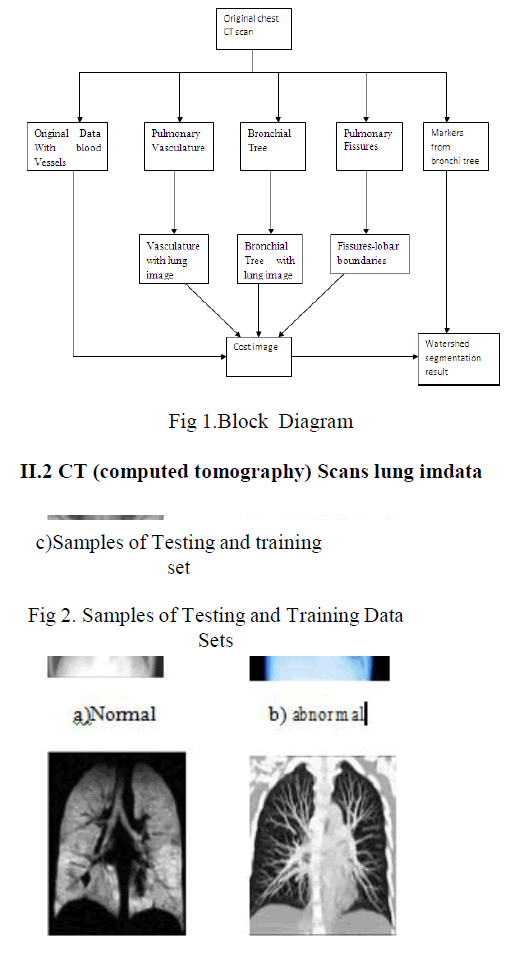 |
DEMAND FORECAST |
| linear regression method: Regression means dependence and involves estimating the value of a dependant variable Y, from an independant variable X. in simple regression, only one independent variable is used. the simple regression takes the following form |
| Y = a + bX |
| where, |
| Y – dependant variable |
| X – independant variable |
| a – intercept |
| b – slope |
DATA COLLECTION |
| Types of maintenance carried out: |
| • Periodic maintenance |
| • Express maintenance |
| Maximum Inventory Position (MIP): |
| Working days in a month = 20 |
| Monthly Average Demand (MAD) = 40 pieces/month |
| Order Cycle is 1 day = 1/20 = 0.05 months |
| Lead Time is 1 day = 1/20 = 0.05 months |
| Safety Stock is 3 days = 3/20 = 0.15 months |
| MIP = MAD x (1+1+3)days |
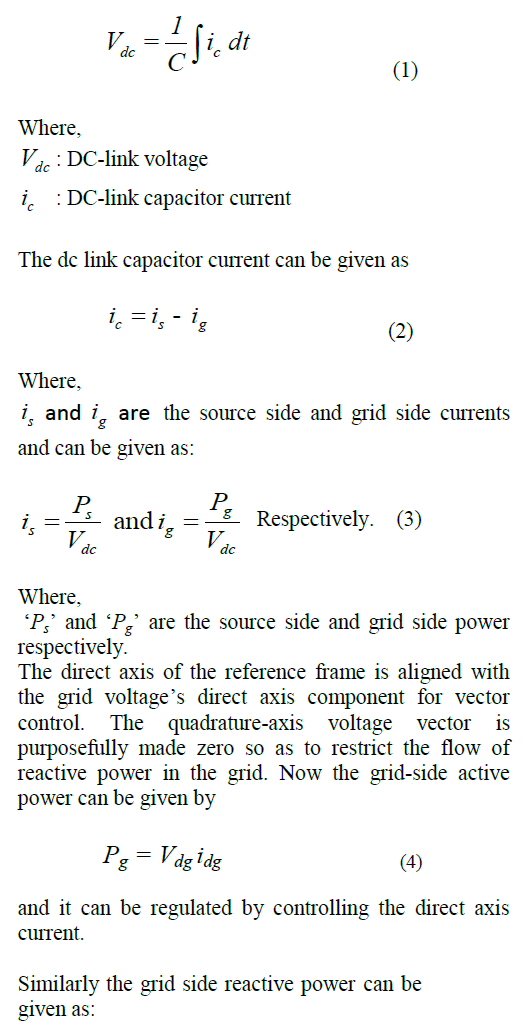 |
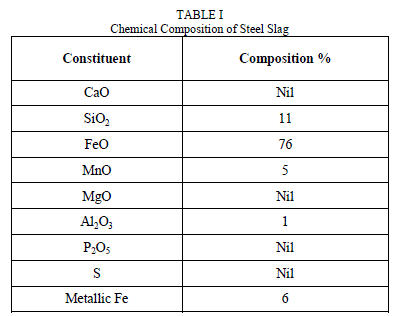 |
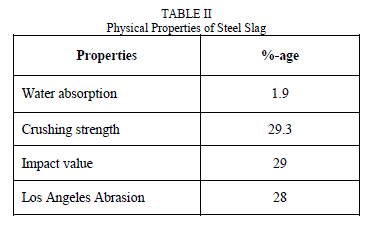 |
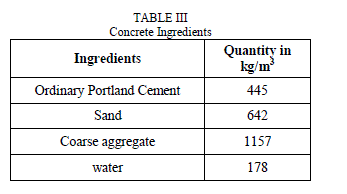 |
Brake Fluid: |
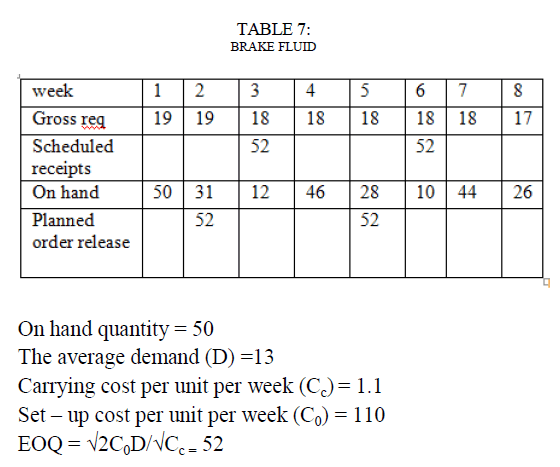 |
CONCLUSION |
| This paper delivers the advantage of Material Requirement Planning (MRP) in ensuring materials on time for service and delivery to customer. Forecasted demand gives the input to MRP for the next purchase of materials. It controls the high inventory level and low inventory level of materials by maintaining the need amount in the industry. It plans manufacturing activities, delivery schedules and purchasing activities in service plant. Finally Material Requirement Planning (MRP) reduces the maintenance and carrying cost of industry. It improves the unbroken chain of components for service and delivers vehicle on time. |
References |
|